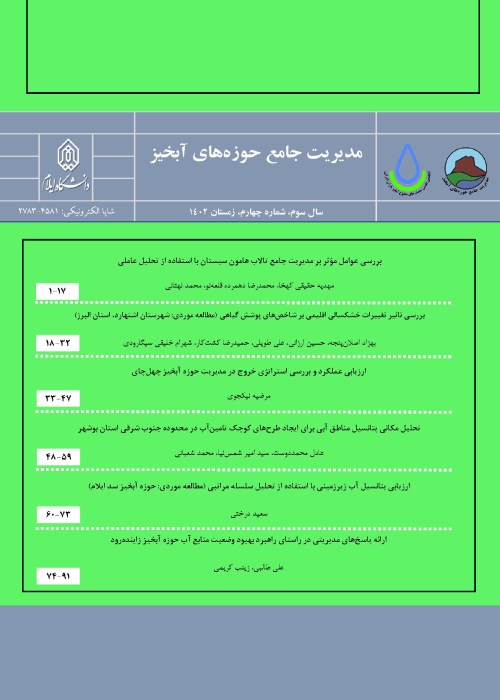Determining the Capability of Agricultural Lands and the Degree of Compliance with the Principles of Environmental Management (Case Study: the Chehelgazi Sub-basin, Kurdistan Province)
Land suitability is the coordination of land characteristics with existing land use that aims at development without degradation, so that the natural talent of the land along with economic potential determine the type of land use (Babapour & Khorasani Alamdari, 2013). The importance of assessing land status and its potential becomes apparent when, if land potentially lacks potential for a particular use, its implementation would lead to environmental degradation, even in spite of the socio-economic need for that use (Brazier & Greenwood, 1998). Also, the challenge in the field of sustainable agricultural development is the issue of food security, whose importance, due to the growing trend of population in the country and increasing food needs, doubles (Halabian & Ismaili, 2018); Therefore, in this regard, it is necessary to evaluate the ecological potential for agricultural use based on the correct principles, patterns and instructions, compare it with current uses, and determine their compliance and non-compliance in order to use it properly based on the natural capability of the region and prevent further degradation and erosion. It seems (Kamyabi va Khosh Agha, 2017). The purpose of this study was to investigate the spatial status of rainfed arable lands in the Chehelgazi Sub-basin according to the proposed models and instructions and to use the GIS in order to assess land suitability, provide planning models and make management decisions in the field of development, in line with natural resources and sustainable agriculture, and in accordance with the reality of agricultural system in Iran.2-
In this study, first, a map of rainfed arable lands under the Chehelgazi Sub-basin was prepared and adapted according to the proposed patterns and instructions in the spatial adaptation of arable lands. Finally, using GIS software, the status of alignment or non-alignment of agricultural lands in the region with the proposed patterns and instructions, as well as the dominant cultivation of the region was determined. The map and percentage of agricultural lands were also determined.3-
After examining the spatial status of arable lands in Chehelgazi sub-basin according to the proposed patterns and instructions in the field of adaptation, the results show that, in terms of slope status, 64.15% of the total land is in line with the proposed instructions, on a slope of less than 16%. In terms of altitude, 37.78% of the lands with a suitable slope are located at the proposed height. In terms of river condition, 29.43% of lands with suitable height and slope are located at a suitable distance from the river. In terms of radiation status, 8.29% of the lands in line with the proposed slope and height are located in the flat, north and west directions. In terms of rainfall status, the total area of the basin is in line with the proposed instructions in rainfall of more than 350 mm.In terms of communication status, most of the lands are located at a direct distance of less than 10 km. Finally, out of the total area of 31117.94 hectares of rainfed arable lands of Chehelgazi Sub-basin, assuming low impact on the slope or sunshine, 29.43% of the total lands have the necessary conditions in terms of slope, height and distance from the river and road.4-
The results show that the the Chehelgazi Sub-basin is generally in poor condition in terms of the development of rainfed agricultural land use; therefore, considering the importance of adapting the user to the relevant goal in order to increase proper performance and increase production, it is suggested that the patterns and guidelines introduced in this research for principled planning and correct decision making as well as training, promotion and implementation of useful projects related to land management and prevention of the destruction of natural resources and the environment should be considered and developed based on the reality of the agricultural system of Iran.
- حق عضویت دریافتی صرف حمایت از نشریات عضو و نگهداری، تکمیل و توسعه مگیران میشود.
- پرداخت حق اشتراک و دانلود مقالات اجازه بازنشر آن در سایر رسانههای چاپی و دیجیتال را به کاربر نمیدهد.



